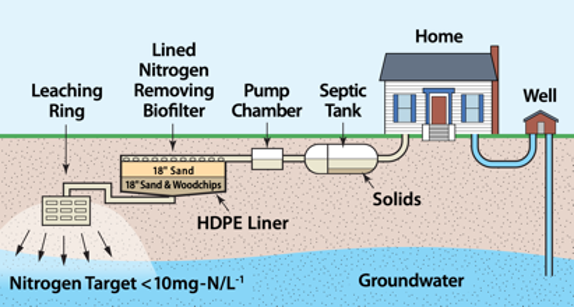Center’s Nitrogen Removing Biofilter Set to Transform Onsite Wastewater Treatment on Long Island and Beyond
December 11, 2023 - A decade ago, citizens across Long Island stood at shorelines and witnessed discolored surface waters or went to the seafood market and found an absence of bay scallops and wondered what was happening. A decade later, we know that those discolored waters were harmful algal blooms (HABs), or the overgrowth of particular microalgae that can be harmful to humans, marine life, and entire ecosystems. We also know those HABs are being intensified by nitrogen loading from land and that across nearly all of Long Island, that nitrogen is coming primarily from wastewater. In Suffolk County and the north shore of Nassau County, most of that nitrogen comes from household, onsite wastewater. In recognition of these facts, the New York State Center for Clean Water Technology (CCWT) was founded in 2015 to develop efficent and cost-effective solutions for mitigating onsite wastewater. One of the Center’s first actions was to develop an innovative and alternative onsite wastewater treatment system (I/A OWTS) that would reduce nitrogen levels as low as possible and would be inexpensive to install and operate. The Center created the Nitrogen Removing Biofilter (NRB) and in April 2023, we reached an important milestone nearly seven years in the making: The provisional approval of our NRB for use across Long Island. Along that journey, the Center made a series of discoveries that positions the NRB as a critical solution to solve onsite wastewater problems on Long Island and beyond.
 One of the Center’s first projects was to undertake a deep dive into the science and
market for I/A OWTS and identify the conceptual framework of NRBs as a potentially
ideal design solution due to its simplicity, limited reliance on mechanical parts
and relatively low maintenance and energy consumption. NRBs utilize a timer and pump
to distribute wastewater across a drain field that is underlain by a layer of sand
which is, in turn, underlain by a lined layer of sand and woodchips. This simple
design allows for wastewater nitrogen to be nitrified in the sand bed, denitrified
in the sand and woodchip biofilter and, then degassed to the atmosphere. The design
has proven to be highly effective. In official pilot testing at eight locations across
Suffolk County, the lined NRB system achieved lower nitrogen effluent than any system
tested in Suffolk County to date. In addition, the Center has published two scientific articles in international peer reviewed journals that showed NRBs remove between 50 and 100%
of drugs, pharmaceuticals, personal care products, and solvents from wastewater; these
removal percentages are better than sewage treatment plants and better than any known
I/A OWTS.
One of the Center’s first projects was to undertake a deep dive into the science and
market for I/A OWTS and identify the conceptual framework of NRBs as a potentially
ideal design solution due to its simplicity, limited reliance on mechanical parts
and relatively low maintenance and energy consumption. NRBs utilize a timer and pump
to distribute wastewater across a drain field that is underlain by a layer of sand
which is, in turn, underlain by a lined layer of sand and woodchips. This simple
design allows for wastewater nitrogen to be nitrified in the sand bed, denitrified
in the sand and woodchip biofilter and, then degassed to the atmosphere. The design
has proven to be highly effective. In official pilot testing at eight locations across
Suffolk County, the lined NRB system achieved lower nitrogen effluent than any system
tested in Suffolk County to date. In addition, the Center has published two scientific articles in international peer reviewed journals that showed NRBs remove between 50 and 100%
of drugs, pharmaceuticals, personal care products, and solvents from wastewater; these
removal percentages are better than sewage treatment plants and better than any known
I/A OWTS.
“We were confident the NRBs would be highly efficient at removing nitrogen. The removal
 of the other pollutants was a happy accident. We have discovered that microbes are
actually breaking down and destroying these compounds in the upper sand layer of the
NRBs.”, said Dr. Chris Gobler, Director of CCWT. “Given pre-existing problems with groundwater contamination with
these compounds, these systems will help keep Long Island’s drinking water clean.”
of the other pollutants was a happy accident. We have discovered that microbes are
actually breaking down and destroying these compounds in the upper sand layer of the
NRBs.”, said Dr. Chris Gobler, Director of CCWT. “Given pre-existing problems with groundwater contamination with
these compounds, these systems will help keep Long Island’s drinking water clean.”
Last summer, CCWT held training sessions for professionals, engineers and construction firms to demonstrate how to design and install NRBs correctly. The Center’s next goal is to have a total of 20 of their lined NRBs installed to gain approval for general use on Long Island.
In addition to the lined NRB, the Center has also designed and installed 10 woodchip box NRBs that have drain field underlaid with sand layers that subsequently direct flow to a woodchip box to remove nitrogen. This design allows for easier access to the woodchips and is expected to achieve provisional approval for installation in 2024.
